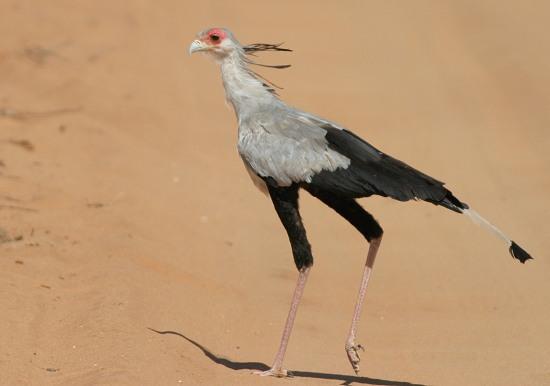Secretary bird
Scientific Name: Sagittarius serpentarius
Sun, 27th April, 2025 - 12:46 am GMT
Sponsor Ads:

Alternative Name
Scientific Name: Sagittarius serpentariusBasic Info
Secretary Birds are usually three feet tall and weigh between seven and a half and nine pounds. Their wingspans can comprise six and a half feet. Male Secretary Birds are smaller than females. Their peach colored legs are also very long and are heavily armored to protect the bird from snakebites. The crest of black-tipped feather plumes that adorns the head of the Secretary Bird was thought to resemble a quill pen tucked behind a secretary's ear, which is the reason this bird is named as it is. The faces of Secretary Birds are orange from the blue-gray bill to the eyes; the eyelids are also orange. The bodies of Secretary Birds are predominantly gray. The wings and thighs are black in color. Two very long black feathers that stick straight out from the center characterize the tail.
Health
Some people keep Secretary Birds to eliminate snakes and rats that may become problematic in their living areas. They are not, however, immune to snake venom and should be tended to if bitten. Breeding Courtship for Secretary Birds often involves both birds clasping each other's talons. Soaring flight and vocalizations are also commonly observed. Secretary Birds make tall nests of sticks and twigs atop a bush or tree. The nests are lined with pellets, dung, or grass. Breeding usually correlates with periods of food abundance. One to three eggs are laid, and both sexes incubate them. After an incubation period of about six to seven weeks, hatchlings covered in gray down emerge. Both parents feed the young Secretary Birds. They usually fledge when they are between two and a half and three and a half months old.Habitat
Open plains, sparse bushlands, or flat agricultural areasBehavior
The beautiful Secretary Bird is a bit different from the type of bird many people might picture when they think of a raptor. However, these exquisite birds are raptors, belonging to the order "Falconiforms". The Secretary Bird usually hunts alone or with its mate.The method used for hunting involves brushing the feet along the ground to flush prey from hiding areas and then snatching it or crushing it with the feet. Although the Secretary Bird can fly, soaring gracefully, it is more often found on the ground. These birds have been known to walk up to 20 miles in a day. Running is the preferred method of escape from danger, though if pressed, the bird may fly. Usually Secretary Birds remain with their mates for long periods of time, though breeding usually occurs only when food is readily available.Origin
AfricaHistory
Native to sub-Saharan Africa, Secretary Birds inhabit open plains, sparse bushlands, or flat agricultural areas. There has been some dispute about the family of the Secretary Bird. Many people argue that it is more closely related to the Crane family than to the Falcon family. The Secretary Bird is slowly diminishing in number throughout its range, and for this reason, trading of this bird is restricted. An alternative naming theory to the quill pen secretary proposition is found in translation errors. In Arabic, the Secretary Bird is called "saqu ettair", meaning hunter bird. It is thought that the name may have sounded similar to the French "secrétaire", and thus been translated into English as "secretary".Common Foods
It eats any small animals that it can catch, namely rodents, birds and their eggs, insects, and reptiles.Sponsor Ads:
For a man of fortitude, there are no walls, only avenues. -- Unknown
Secretary bird
Coded by: BGID® | ALL RIGHTS RESERVED Copyright © 2000-2025
Disclaimer | Privacy | Report Errors / Contact | Credits








 Why haven't we as a collective earth met with aliens yet?
Why haven't we as a collective earth met with aliens yet?  The Best Text Adventure You Will Ever Play! The official site:
The Best Text Adventure You Will Ever Play! The official site:  Homosexual behavior stems from the mind or genetics?
Homosexual behavior stems from the mind or genetics?  World EcoSystem - Biodiversity Changes - Who is on board and who isn
World EcoSystem - Biodiversity Changes - Who is on board and who isn  Mouthwash - Mouthrinse - Mouth Sores - Healing Infections - Gingivitis
Mouthwash - Mouthrinse - Mouth Sores - Healing Infections - Gingivitis  Treatment for Depression
Treatment for Depression  Ultra radical and violent Islamist group that even rivals Al Qaeda
Ultra radical and violent Islamist group that even rivals Al Qaeda  An idea to have teachers who want to carry guns to school undergo some level of police training will be left up to local school districts and police departments.
An idea to have teachers who want to carry guns to school undergo some level of police training will be left up to local school districts and police departments.